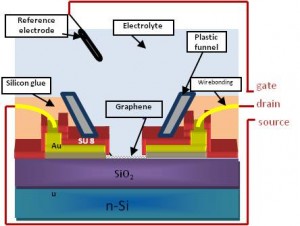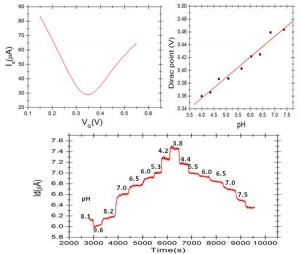Graphene-based Chemical and Biological Sensors
- Category: Electronic Devices, Nanotechnology
- Tags: Benjamin Mailly Giacchetti, Jing Kong, Tomas Palacios
Thanks to its all-surface 2D structure combined with a very high carrier mobility, graphene is a very promising candidate for high sensitivity and low noise chemical sensing [1] [2] . Indeed, graphene devices can perform electrical detection for chemical sensing in a wide variety of applications, including pH monitoring in electrolytes [3] [4] ; glucose measurements in blood; and in-vitro recording of the electrical activity of living cells [5] .
Our group has developed the first solution-gated graphene field effect transistor (SGFET) arrays. These devices have important advantages with respect to traditional sensors, including intrinsic signal amplification, simple electronic read-out, and straightforward integration with microelectronics. Figure 1 shows a diagram of the graphene biosensor device and operating procedure. We use graphene grown by chemical vapor deposition as the active channel of these new devices. After fabricating graphene transistors with our standard technology, an SU8-based encapsulation technology has been developed to protect the contacts and wires from the electrolyte.
As seen in Figure 2.a), the characterization of our devices in a phosphate buffer solution displays high transconductances around 5 mS.mm-1 (or 6 mS.V-1 if normalized by the drain-source voltage). This high response highlights the very good sensitivity of our sensor compared to the conventional silicon devices, which typically have 20 times lower transconductances. The pH measurements have been performed using these devices, by recording how the Dirac point shifts with changes in pH, as shown in Figure 2.b). Sensitivity as high as 30 mV/pH have been demonstrated in this way. In addition, long term pH monitoring was shown for the first time in graphene devices, as shown in Figure 2.c). Our on-going work focuses on functionalizing graphene to demonstrate new biosensors focused on glucose detection. We are also optimizing the fabrication process to improve the sensitivity and decrease the noise of the devices.
- Figure 1: Schematic illustration of the experimental setup for graphene solution-gated FET.
- Figure 2: Graphene transistor, 9×60 mm2 in size, a) Drain-source current change with electrolyte gating voltage Vg in 10 mM phosphate buffer, drain-source voltage VDS=50mV. b) Dirac point shift with pH. c) Drain-source current versus time data for values of pH between 10 and 3.5 with Vg=0.4V and VDS=10mV.
- M. Dankerl, M. V. Hauf, A. Lippert, L. H. Hess, S. Birner, I. D. Sharp, A. Mahmood, P. Mallet, J. Veuillen, M. Stutzmann, and J. A. Garrido, “Graphene solution-gated field-effect transistor array for sensing applications,” Adv. Funct. Mater., vol. 20, pp. 3117-3124, Sep. 2010. [↩]
- B. Mailly Giacchetti, A. Hsu, H. Wang, K. K. Kim, J. Kong, and T. Palacios, “CVD-grown graphene solution-gated field effect transistors for pH sensing,” MRS Proceedings, vol. 1283, 2011. [↩]
- Y. Ohno, K. Maehashi, Y. Yamashiro, and K. Matsumoto, “Electrolyte-gated graphene field-effect transistors for detecting pH and protein absorption,” Nano Lett., vol. 9, pp. 3318-3322, Sep. 2009. [↩]
- P. K. Ang, W. Chen, A. T. Wee, and K. P. Loh, “Solution-gated epitaxial graphene as pH sensor,” J. Am. Chem. Soc., vol. 130, pp. 14392-14393, Nov. 2008. [↩]
- T. Cohen-Karni, Q. Qing, Q. Li, Y. Fang, and C. M. Lieber, “Graphene and nanowire transistors for cellular interfaces and electrical recording,” Nano Lett., vol. 10, pp. 1098-1102, Mar. 2010. [↩]

